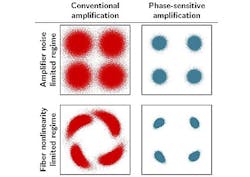Ultralow-noise optical amplifiers enable fiber-optic transmission over a distance of 4000 km
| Recovered-signal constellation diagrams compare conventional amplification and phase-sensitive amplification in an amplifier-noise-limited regime (-2 dBm launch power) and a fiber-nonlinearity-limited regime (8 dBm launch power). (Illustration: Samuel Olsson) |
Researchers from Chalmers University of Technology (Gothenburg, Sweden) and Tallinn University of Technology (Tallinn, Estonia) have demonstrated a 4000 km fiber-optic transmission link using ultralow-noise, phase-sensitive optical amplifiers.1 This is a reach improvement of 5.6 times what is possible when using conventional optical amplifiers.
The reach and capacity in today's fiber-optic transmission links are both limited by the accumulation of noise originating from optical amplifiers in the link, and by the signal distortion from nonlinear effects in the transmission fiber. In this new demonstration, the researchers showed that the use of phase-sensitive amplifiers can significantly and simultaneously reduce the impact of both of these effects.
Using phase-sensitive amplifiers adds 6 dB less noise than using conventional erbium-doped and other phase-insensitive fiber amplifiers, and at the same time mitigates the effects of optical nonlinearity. In addition, a link using the phase-sensitive amplifier transmits two data-carrying waves, resulting in twice the bandwitdh of a link using a phase-insensitive amplifier.
"While there remain several engineering challenges before these results can be implemented commercially, the results show for the first time, in a very clear way, the great benefits of using these amplifiers in optical communication," says Peter Andrekson, who leads the research on optical communication at Chalmers. "Such amplifiers may also find applications in quantum informatics and related fields where generation and processing of quantum states are of interest, as well as in spectroscopy or any other application which could benefit from ultralow-noise amplification."
The research was funded by the European Research Council (ERC), the Swedish Research Council, and the Wallenberg Foundation.
REFERENCE:
Samuel L.I. Olsson et al., Nature Communications (2018); doi 10.1038/s41467-018-04956-5
